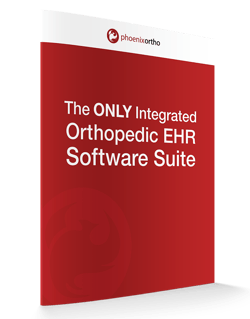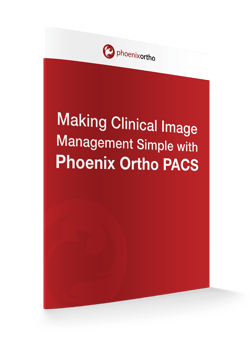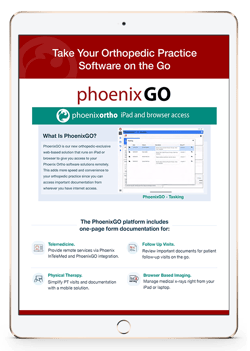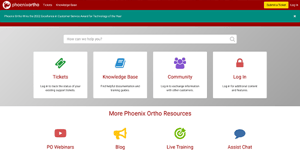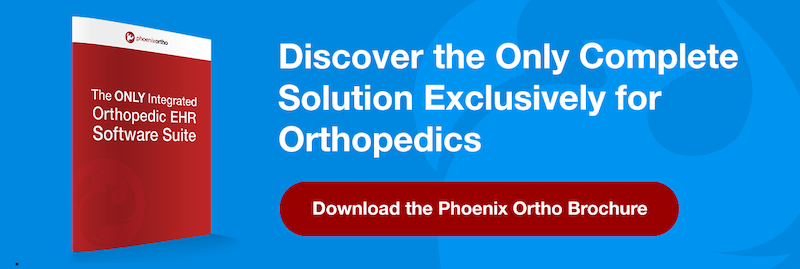Orthopaedic practices everywhere can benefit greatly from using a picture archiving and communication system (PACS). Why do orthopaedic clinics, in particular, need a PACS imaging system for their practice?
Here is a quick explanation of what a PACS software is, how it works, and the benefits of picture archiving and communication systems.
What Are PACS Systems and How Do They Work?
TechTarget’s SearchHealthIT has a good, if simple, definition of what a PACS imaging system is: “a medical imaging technology used primarily in healthcare organizations to securely store and digitally transmit electronic images and clinically-relevant reports.” Pictures that are captured by modern imaging devices are transferred to a digital image storage server. From there, the image can be readily accessed by any authorized caregiver with the tablet or smartphone app for that PACS imaging system in seconds.
The goal of using a PACS imaging software is to make it easier for caregivers to access necessary patient images—such as x-rays or MRIs—so they can provide a higher quality of care. Image acquisition is often a major hurdle for orthopaedic clinics, as having to wait for the retrieval of hard copies of delicate x-rays and other images is a common cause for delays in patient care.
In most cases, PACS imaging systems are a separate solution from the Electronic Health Record (EHR) software used by a clinic. However, some solutions integrate PACS and EHR into a single software to provide seamless management for multiple aspects of a practice.
What Are the Benefits of Picture Archiving and Communication Systems?
Some commonly-cited benefits of having a PACS system for image acquisition and distribution include:
- Fast Image Retrieval. With a PACS software solution, caregivers in an orthopaedic practice can retrieve patient images in seconds rather than having to wait for hard copies to be shipped to their clinic (or relying on patients to remember their records).
- Emergency Image Backups. Imaging systems can also fulfill the role of emergency backups in case of a disaster. With a set of remotely-stored image files, clinics can download copies of images in case of loss or damage to their locally-stored files.
- Reduced Reliance On Hardcopy Images. Because images can be seen on mobile devices in an instant, clinics have less need for physical copies of images. This reduces the physical space needed in the clinic for their filing system—which can help practice owners/managers either expand their available space for examination rooms or save money on floor space in their rent/lease agreements.
- Interfacing with Other Patient Charting Software. When integrated with a patient charting solution, PACS software can greatly simplify clinical workflows, enhance collaboration between caregivers, and improve the quality of patient care in an orthopaedic clinic that relies heavily on images to make accurate and speedy care decisions.
The last bullet is especially important, as an integrated PACS imaging system that is part of the practice’s EHR software can simplify processes and make tasks easier. A separate solution that is not integrated, on the other hand, may add complexity and labor by requiring caregivers to switch between software programs.
Two Ways to Integrate a PACS Software with Your EHR Solution
There are two general methods for integrating a PACS software with your Electronic Health Records software:
- Setting Up a Custom Integration. Here, the orthopaedic practice takes painstaking measures to either create a custom application program interface (API) for the PACS software to make it work with their existing EHR software, or alter their workflow to accommodate a new software solution that is separate from their existing software.
- Acquiring a Software That Combines PACS and EHR, Solutions. As mentioned earlier, it is possible for an EHR solution provider to offer an integrated software solution that creates a tool where caregivers can use to easily access all of the information and images they need about a patient with the fewest possible number of mouse clicks.
Of these two methods, acquiring a PACS imaging software that is already integrated with an existing EHR solution is, by far, the simplest and easiest method. By using an integrated solution, you:
- Only Have to Learn One Software. Onboarding a new software solution can be difficult. Using an integrated EHR solution such as Phoenix Ortho makes it easier by providing all of the tools you need in a single software (and by supplying onboarding services complete with a dedicated implementation specialist).
- Can Simplify Your Bill Pay. Having fewer vendors means less complexity for your accounts payable each month. This simplifies your practice management and minimizes the risk of accidentally missing a payment to a vendor in any given month.
- Only Need to Manage One Vendor for Software Service. With a PACS system that is part of a complete patient charting solution, if you have an issue with the software, you only need to contact one vendor. With a manually-integrated solution, you may need to contact each vendor for the different software programs you are trying to manage, as programming conflicts from one may affect another.
- All Of Your Medical Charting Data Lives on a Single Database. With a truly integrated EHR and PACS solution, all of the data for your patient charts, including imaging data, lives on one database. This means that there is no need to switch from one software and login to another simply to reference patient images during each visit. This means less time wasted on data entry and more time spent attending patients.
Need help maximizing your orthopaedic practice’s efficiency with the best PACS system for your needs? Speak to a PACS specialist from Phoenix Ortho today!
Schedule a 1:1
Get in touch with Phoenix Ortho to learn more about how you can save time, money, and mouse clicks with an orthopedic-specific EHR.





